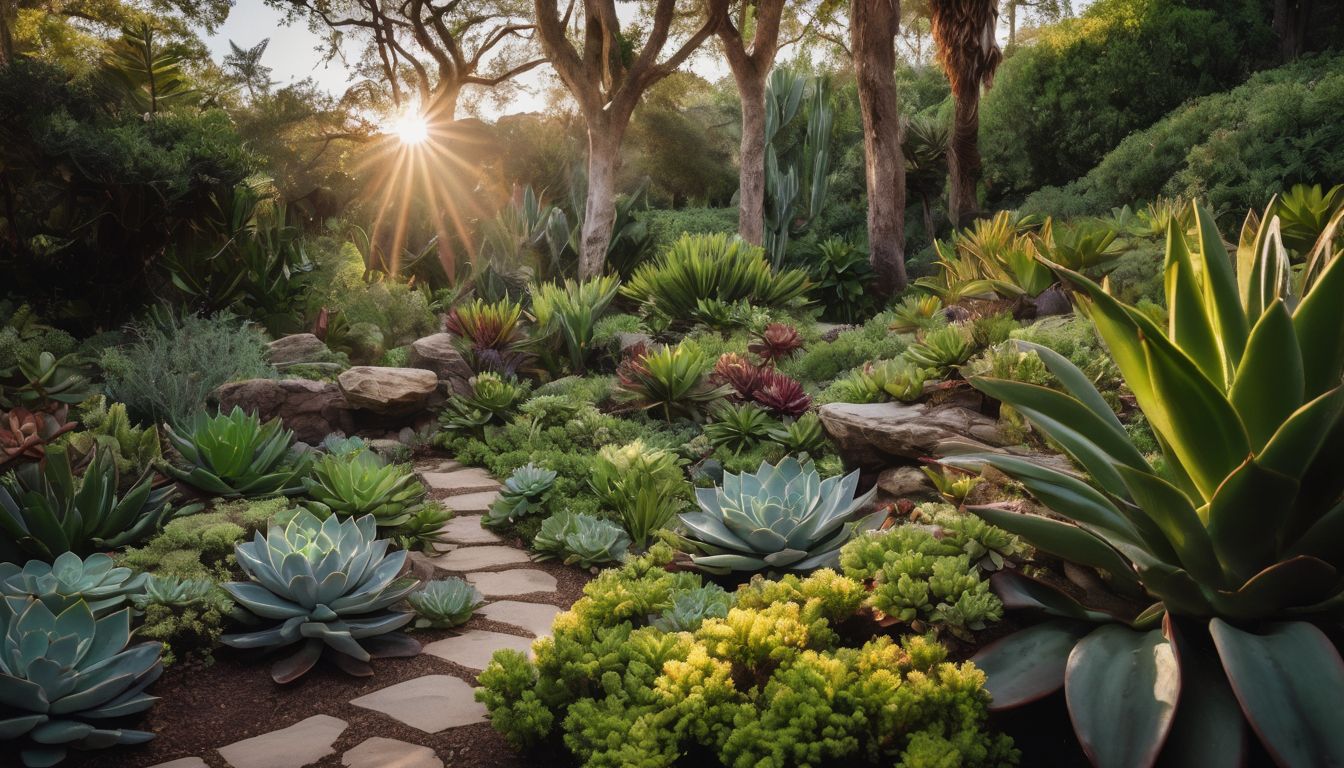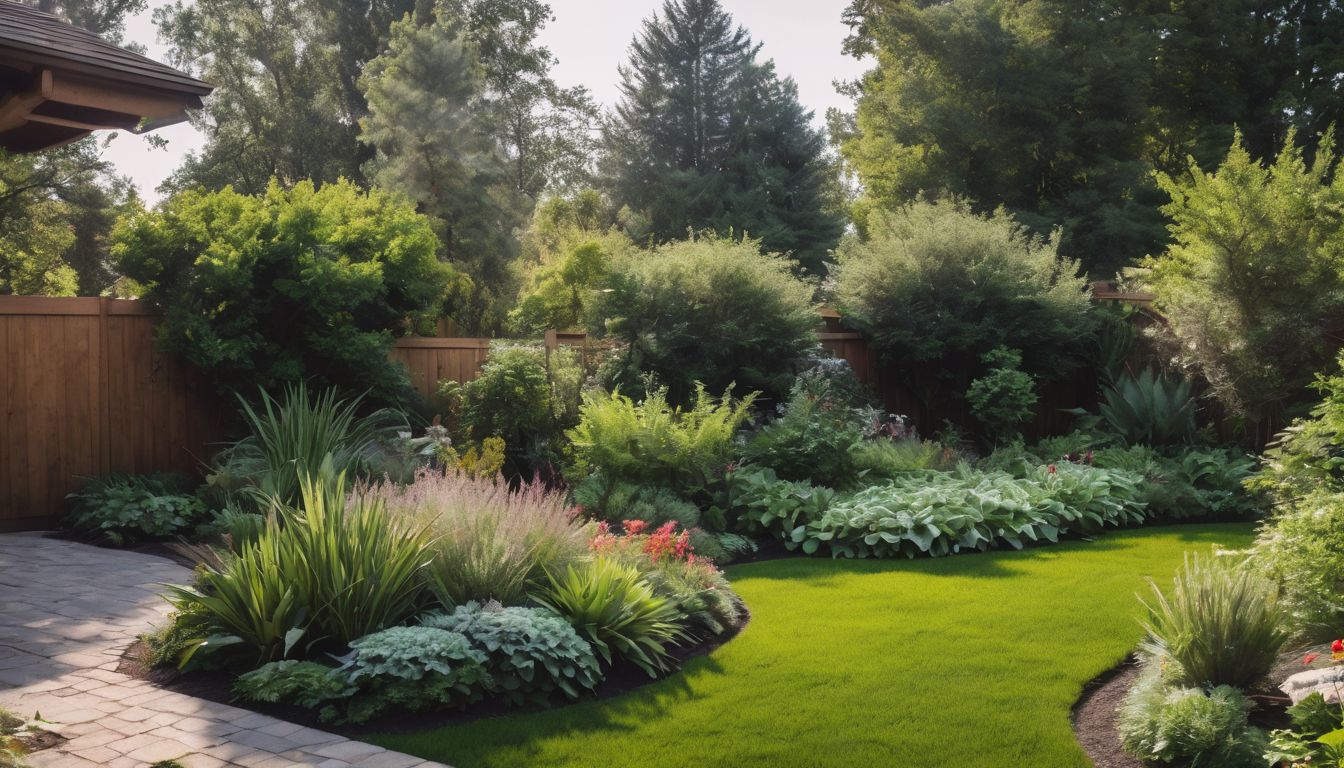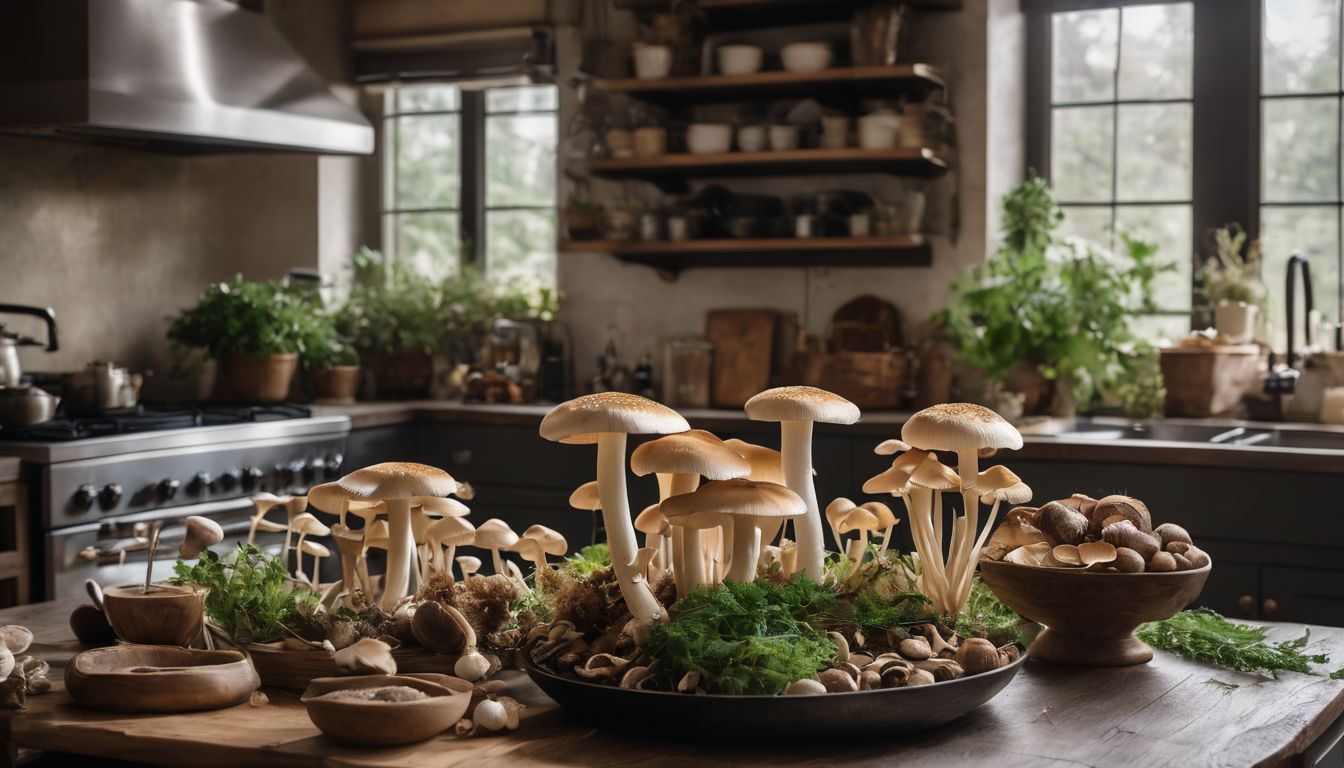Creating a garden that delights both adults and children can often feel like a tricky balancing act. A staggering 65% of UK households wish for a family-friendly outdoor space, yet struggle to integrate playfulness with practicality.
Our guide will simplify the process, offering clear steps to transform your backyard into an enchanting haven for kids’ adventures and learning. Let’s dig in and design the perfect child-friendly garden together!
Key Takeaways
- Start your child – friendly garden design by conducting a thorough survey and creating a scaled plan to outline different zones for play, relaxation, and learning.
- Choose natural, non-toxic materials for the garden such as untreated wood and gravel pathways, avoiding harmful substances like lead-based paint and pressure-treated timber.
- Mix height variations with transition spaces like mounds or slopes in your design to add adventure while ensuring all play equipment is safely installed over soft surfaces.
- Integrate sensory elements through plants that encourage touching, smelling, and tasting along with building a bug hotel to attract wildlife and offer educational opportunities.
- Regular maintenance of the garden ensures safety for children and preserves its beauty, promoting a continuous connection between young ones and their outdoor environment.
What is a Child-Friendly Garden?
A child-friendly garden is a safe and engaging outdoor space designed with the needs and interests of children in mind. It’s a place where kids can explore, learn, and play in a natural setting that stimulates their imagination and encourages physical activity.
The garden features elements like soft grassy areas for tumbling, paths for little feet to follow, and hidden corners to inspire games of hide-and-seek. Plants are chosen not only for their beauty but also for their sensory appeal – plants that invite touching, smelling, and even tasting.
This special type of green space integrates interactive features such as sandpits or water play areas that provide tactile experiences. It might include designated spots where children can grow their own flowers or vegetables, fostering an appreciation for nature and understanding environmental conservation from a young age.
Play equipment should blend safety with fun; think swings set over mulch or bark chips instead of concrete surfaces. Overall, these gardens create an inviting atmosphere where families can come together to enjoy the outdoors while offering children a canvas on which to paint their adventures.
Designing a Child-Friendly Garden:
When designing a child-friendly garden, it’s important to start by drawing up a garden survey and creating a scaled plan. Incorporating height and transition spaces, suitable play equipment, wild play areas, child-friendly plants, trees, and shrubs are all essential elements to consider.
Building a bug hotel can also add an educational aspect to the garden.
Draw up a garden survey
To design a child-friendly garden, begin by drawing up a garden survey. This will help you to evaluate the available space and understand the layout of your garden. Identify existing features such as trees, fences, sheds, and any sloped areas. Consider aspects like sunlight exposure, wind direction, and potential hazards in the space.
Determine the number of zones needed
To design a child-friendly garden, evaluate the available space and decide how many distinct zones are necessary. Consider creating separate areas for active play, relaxing, and planting to provide diverse experiences for children.
Take into account the layout of your garden and the different activities you want to incorporate in each zone, ensuring it meets the needs of your family while promoting outdoor learning and exploration.
Once you’ve identified the number of zones required, think about how each area can integrate with other parts of your child-friendly garden. Keep in mind that having multiple zones enables children to engage in various activities simultaneously and creates natural flow within the outdoor space.
Create a scaled plan
To design a child-friendly garden, start by drawing up a detailed garden survey. Determine the number of zones required for different activities and create a scaled plan to ensure all elements fit harmoniously.
This process will help in visualising the layout and aid in incorporating suitable play equipment, wild play areas, as well as child-friendly plants, trees, and shrubs within each zone.
Developing a scaled plan ensures that space is optimally used to provide engaging play areas while also preserving natural habitats. It allows for thoughtful placement of features such as seating areas and transition spaces to craft an interactive outdoor learning space for children.
Once the initial scaled plan is crafted, it provides a roadmap for creating a safe and fun environment whilst promoting curiosity and exploration.
Incorporate height and transition spaces
After creating a scaled plan for the garden, it’s essential to incorporate height variations and transition spaces. Adding different levels and slopes can create visual interest and provide opportunities for adventure and exploration, stimulating children’s curiosity as they navigate through the garden.
Raised beds, mounds, or low walls can delineate areas while offering climbing challenges and hiding spots. Sloped pathways can introduce gentle physical challenges, aiding in the development of balance and coordination.
Integration of these elements promotes engagement with nature in an environmentally conscious manner, enhancing children’s appreciation for the natural world.
Add suitable play equipment and wild play areas
Incorporate slides, swings, climbing frames, and interactive play structures within the garden to create an engaging outdoor play space for children. Integrate natural elements such as boulders, logs, and tree stumps to encourage imaginative and adventurous play.
Create a wild play area with tall grasses, a mini forest with winding pathways, and spaces for den building to foster a sense of exploration and connection to nature. Include sensory elements like sand pits or water features for hands-on learning experiences that promote environmental awareness.
As part of the child-friendly garden design process, consider installing sustainable wooden play equipment that blends seamlessly with the natural landscape while providing safe and enjoyable opportunities for active outdoor play.
Include child-friendly plants, trees, and shrubs
Choose plants that appeal to children’s senses and are safe for them to explore. Opt for vibrant flowers, such as marigolds and sunflowers, or fragrant herbs like lavender and mint.
Ensure the garden features trees with sturdy branches suitable for climbing, such as apple or cherry trees, providing both a natural play area and an opportunity to connect with nature.
Incorporate shrubs like butterfly bushes or elderberry, which attract wildlife for educational purposes while adding interest to the surroundings.
Build a bug hotel
Construct a bug hotel using natural materials like logs, branches, and hollow stems. Choose a sheltered location for the bug hotel to protect it from weather elements. Ensure the bug hotel has various compartments to accommodate different insect species.
Incorporate natural features such as dried leaves, pine cones, and bark to provide hiding spots for bugs. Position the bug hotel close to plants, shrubs, or trees that attract insects.
Invite beneficial insects into your garden by building a welcoming habitat. Place the bug hotel in an area with access to water and nectar-rich flowers. Avoid using pesticides in your garden to encourage insect diversity around the bug hotel.
Creating Zones in a Child-Friendly Garden:
Examples of garden design zones can include a play area, sensory garden, wildlife habitat, and seating or relaxation space. Each zone provides different experiences for children to explore and enjoy in the garden.
Examples of garden design zones
To cater to different interests and activities, a child-friendly garden can be divided into various zones. Here are examples of garden design zones:
- Play area: A dedicated space for play equipment like swings, slides, and climbing frames.
- Wild play area: An area with natural materials like logs, rocks, and sand for unstructured, imaginative play.
- Sensory garden: A zone with plants of different textures, scents, and colours to engage children’s senses.
- Relaxation space: A quiet corner with seating for reading or observing nature.
- Educational zone: Incorporating features like a small vegetable patch or butterfly garden to inspire learning about the environment.
- Wildlife habitat: Creating a space for bugs and birds through features like a bug hotel or bird feeder.
Materials for a Child-Friendly Garden:
Choose natural, non-toxic materials like wooden play structures and gravel for pathways to create a safe and ecologically beneficial environment for children to explore in the garden.
For more information on creating a child-friendly garden with sustainable materials, continue reading.
Suitable materials
Choose natural materials such as untreated wood, stone, and gravel for paths to create a safe and environmentally friendly garden space.
- Untreated Wood: Opt for untreated wood for play structures like sandpits, climbing frames, and treehouses. Avoid chemically treated wood to minimise exposure to harmful substances.
- Stone: Use natural stone for paving and borders. It offers durability, low maintenance, and a natural aesthetic that complements the environment.
- Gravel: Incorporate gravel for pathways or play areas. It provides a tactile experience, allows for water drainage, and can be easily replenished.
- Recycled Materials: Consider using recycled plastic lumber for furniture or composite decking made from recycled materials for sustainability and conservation efforts.
- Organic Fabrics: Utilise organic cotton or hemp fabric for outdoor cushions and seating covers to promote eco-friendly practices while creating comfortable seating areas in the garden.
- Bamboo: Choose bamboo as an alternative to traditional wooden features due to its fast growth rate and sustainable properties.
Materials to avoid
When designing a child-friendly garden, it’s important to avoid certain materials that may pose risks to children or harm the environment. Here are some materials to avoid:
- Lead-based paint: Avoid using any products containing lead as it can be hazardous if ingested by children and harmful to the environment.
- Pressure-treated wood: Steer clear of using pressure-treated wood as it contains chemicals that can be harmful if children come into contact with it.
- Toxic plants: Refrain from planting any toxic plants or flowers in the garden, as they can cause harm if touched or ingested by children.
- Artificial turf with infill: Avoid using artificial turf with infill, as some types may contain harmful chemicals that can be harmful if absorbed through the skin.
- Non-biodegradable plastics: It’s best to avoid non-biodegradable plastics as they contribute to environmental pollution and may pose choking hazards for young children.
- Pesticides and herbicides: Stay away from using chemical pesticides and herbicides in the garden, as they can be harmful to both children and the environment.
- Sharp or pointy objects: Ensure that there are no sharp or pointy objects within the child-friendly garden area, which may pose a safety risk for young explorers.
- Small loose parts: Keep small loose parts such as gravel, rocks or small toys out of the play areas to prevent choking hazards for young children.
- Poorly secured structures: Avoid using poorly secured structures or equipment that may pose a risk of tipping over and causing injuries to children during playtime.
The impact of artificial turf
Avoiding artificial turf in a child-friendly garden can benefit the environment. Synthetic grass is made from non-renewable resources such as petroleum and requires regular maintenance, contributing to air pollution.
Additionally, artificial turf does not support biodiversity, unlike natural grass which provides habitats for insects and wildlife essential to the ecosystem.
Artificial turf also poses health risks to children due to potential harmful chemicals used in its production. Exposure to extreme temperatures may cause synthetic grass to release toxic substances that could harm children’s health as they play on it.
Adding Interest to a Child-Friendly Garden:
Incorporate natural elements like sand pits, water features, and sensory gardens to create a fun and engaging outdoor space for children. Use plants and flowers as educational tools, and integrate seating areas for relaxation in the garden.
Ideas for play areas
Creating unique and engaging play areas in a child-friendly garden is essential to encourage children’s exploration and learning while enjoying the outdoors. Consider the following ideas for play areas:
- Design a sensory garden with different textures, scents, and colors to stimulate children’s senses and promote sensory development.
- Install a water play area with features such as fountains, small ponds, or water tables to provide opportunities for interactive and imaginative play.
- Construct a natural obstacle course using logs, stepping stones, and low hedges to promote physical activity and balance skills.
- Integrate a storytelling nook with tree stumps or wooden seating to encourage children to engage in creative storytelling activities.
- Incorporate musical elements such as wind chimes, drums, or xylophones for children to explore sound and rhythm in an outdoor setting.
- Create hidden spaces like secret gardens or cubby houses where children can retreat for quiet play or imaginative role-playing.
- Build a wildlife observation area with bird feeders, bug hotels, and butterfly gardens to foster an appreciation for nature and wildlife.
Incorporating natural elements
Incorporate natural elements such as rocks, logs, and tree stumps to add texture and interest. Use native plants and wildflowers to attract wildlife and create a biodiverse environment.
Integrate natural pathways using gravel or wood chips to encourage exploration and discovery. Incorporating a water feature like a small pond or stream can provide sensory stimulation for children while also supporting local ecosystems.
Position seating areas near natural elements to allow for observation, relaxation, and connection with the environment.
Utilise planters made from sustainable materials to grow edible plants, encouraging children to learn about gardening and sustainability. Create opportunities for outdoor learning by including bird feeders, insect hotels, and butterfly houses within the garden space.
Using plants and flowers as educational tools
Incorporating natural elements such as plants and flowers is crucial for creating an educational garden environment for children. By integrating a variety of plants, trees, and shrubs, children can learn about the lifecycles of different species while developing an appreciation for nature.
Planting sensory gardens with fragrant herbs, textured leaves, and vibrant blooms not only adds visual appeal but also provides a hands-on learning experience that stimulates their senses.
Additionally, including educational signage about each plant’s characteristics and traditional uses encourages curiosity and environmental awareness in young minds.
Moreover, by incorporating native plants into the garden design, children can grasp the importance of biodiversity and conservation efforts. Observing insects attracted to specific flowers or observing pollinators at work fosters an understanding of ecological relationships.
Integrating seating areas for relaxation
Integrate seating areas within the garden to provide a space for children to rest and unwind. Use natural materials such as logs, tree stumps, or even repurposed wooden crates to create seating that blends seamlessly into the environment.
Incorporate benches or hammocks beneath shaded areas, creating a calm retreat with pleasant views of the surroundings. Choose durable, sustainable materials that complement the garden’s aesthetic while providing a place for both playtime breaks and quiet observation.
Designing diverse relaxation spaces encourages appreciation of nature in young minds, fostering an understanding and respect for the environment. By integrating these areas thoughtfully throughout the garden, children can enjoy moments of respite while connecting with their natural surroundings.
The importance of maintenance and upkeep.
Integrating seating areas for relaxation encourages children to engage with nature. Regular upkeep preserves the safety and aesthetic appeal of a child-friendly garden. Maintenance ensures that play equipment remains in good condition, plant life thrives, and natural elements continue to flourish.
A well-maintained garden provides a safe and inviting space for children to explore, learn, and play while fostering an appreciation for the environment.
Proper maintenance is essential to sustain the functionality and beauty of a child-friendly garden over time. It supports the long-term enjoyment of outdoor spaces by creating a vibrant environment that promotes both conservation values and active engagement with nature.
Conclusion
Designing a child-friendly garden involves careful planning and consideration. Incorporating play equipment, natural elements, and kid-friendly plants can create an engaging environment for children.
By creating different zones and utilising suitable materials, you can design a safe and fun outdoor space that promotes exploration and learning. With proper maintenance and upkeep, your child-friendly garden will provide endless opportunities for outdoor play and sensory experiences.
FAQs
1. What are key features of a child-friendly garden?
Key features include safe and fun garden areas for children, kid-friendly landscaping, sensory gardens that encourage exploration, and dedicated outdoor play spaces that are secure.
2. How can I create a safe play space in my garden for kids?
To create a safe outdoor play area, consider soft ground coverings like grass or rubber mats, securely install playground equipment and ensure the entire space is free from hazards.
3. What kind of activities can I include in an interactive garden for children?
Make your garden family-friendly by adding activities like sandpits for digging, water tables for splashing, musical instruments like chimes to enjoy sounds or vegetable patches where they can learn to grow plants.
4. Can you suggest some child-safe garden features?
For a child-safe backyard, choose non-toxic plants, put up fences around ponds or pools to prevent accidents and use rounded edges on hardscape elements to minimise risks during play.
5. Why should I consider designing a sensory garden for children?
A sensory garden stimulates all five senses through different textures of plants and materials; fragrant flowers; colourful visuals; natural sounds from wind chimes or birdhouses; and edible herbs which fosters learning and discovery in kids while playing outside.





